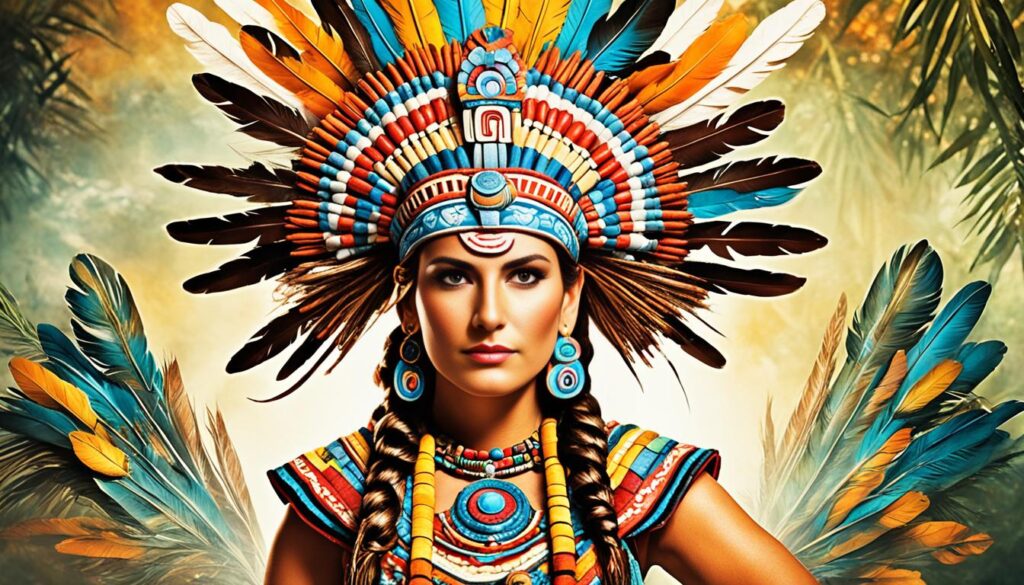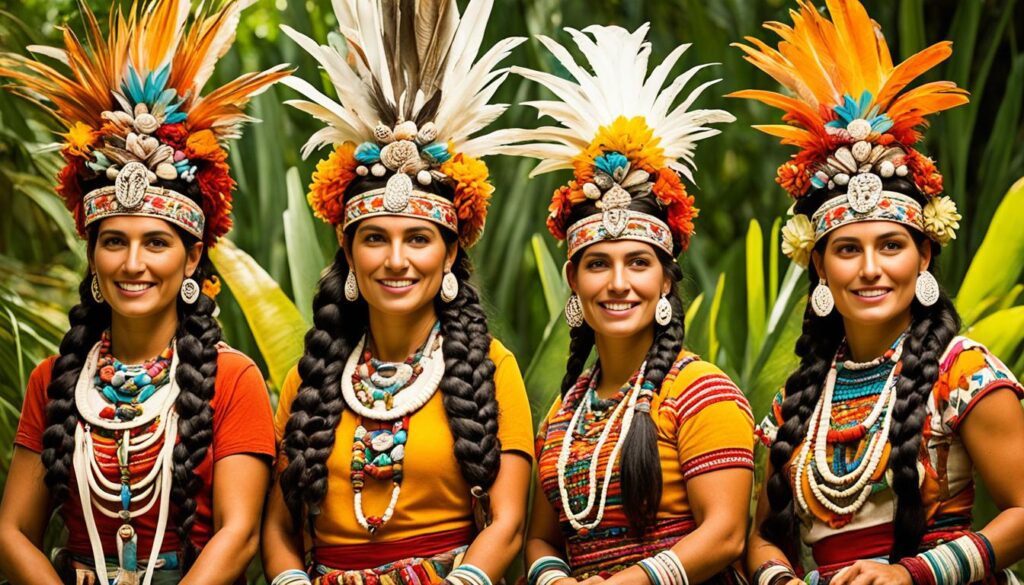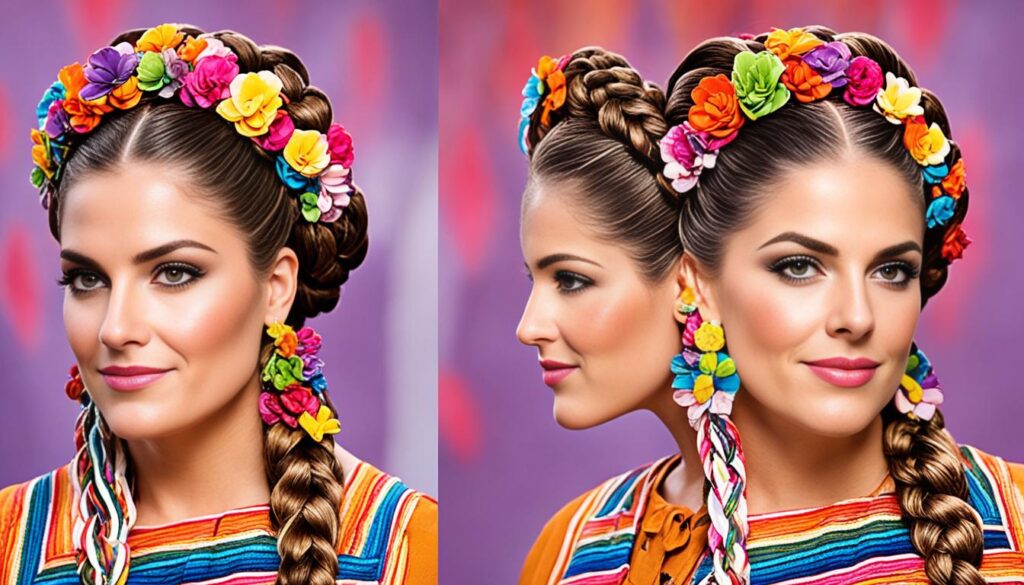
When you think of ancient Mayans, what images come to mind? Perhaps you envision their magnificent temples, intricate hieroglyphics, or vibrant traditional clothing. But have you ever wondered about their hairstyles? Did the Mayans wear braids like many other ancient civilizations? The answer may surprise you.
In ancient Mayan culture, both men and women cherished their long, thick black hair. While men burned the top of their heads to keep it free of hair, they would often braid the rest and roll it into a regal crown. Women, on the other hand, would divide their hair into two parts or braid it at the back, tying it in different ways with a headdress. Interestingly, the hairstyle of a married woman differed from that of a single woman.
Intrigued? Discover more about Mayan hairstyles and the significance of braids in their culture in the following sections.
Key Takeaways:
- Mayan men and women cherished their long, thick black hair.
- Men would burn the top of their heads and braid the remaining hair into a crown.
- Women would divide their hair or braid it at the back and tie it with a headdress.
- The hairstyle of a married woman was different from that of a single woman.
- Mayan hairstyles were an important part of their cultural identity.
Mayan Hairstyles and Headdresses
The Mayans had a rich cultural tradition when it came to hair and headdresses. They showcased great magnificence in their headdresses, meticulously crafted and adorned with symbolic elements. These headdresses were made from wicker or wood and shaped in the likeness of various creatures such as a jaguar, bird, serpent, or even a god.
The frames of the headdresses were covered with exquisite materials, including jaguar skin, mosaics of feathers, and intricately carved jade. These luxurious embellishments demonstrated the wearer’s elevated social status and their connection to the divine. The high plumes of feathers, ranging from vibrant colors to iridescent hues, added an element of royalty and elegance to the overall aesthetic of the headdresses.
Nobles often adorned their headdresses with additional elements, such as bouquets of flowers and aromatic herbs, further enhancing their regal appearance and adding a fragrant touch to their presence.
“Mayan headdresses were a remarkable display of artistry, showcasing the Mayan people’s deep reverence for nature, spirituality, and social hierarchies.”
The intricate craftsmanship and elaborate details of these headdresses offer a glimpse into the rich culture and traditions of the Mayan civilization. They reflect the Mayans’ profound appreciation for beauty, their connection to the natural world, and the divine significance they attributed to their customs and adornments.
| Materials | Symbolism |
|---|---|
| Jaguar skin | Represented power and strength |
| Feathers | Symbolized the connection between Earth and the spiritual realm |
| Carved jade | Signified prosperity and divinity |
Mayan Hair and Head Style
The Maya had unique hairstyles and head practices that were integral to their culture. These practices included head deformation and the adoption of specific hair styles. Let’s explore these fascinating traditions in more detail.
Head Deformation
One distinctive aspect of Mayan culture was their practice of achieving a round face and flattened top by binding or compressing a newborn’s head. This practice, known as head deformation, served as a symbol of beauty and social status within the Mayan community.
This process involved tightly wrapping the infant’s head with cloth or other materials to mold the shape of the skull. The applied pressure gradually altered the skull’s growth pattern, resulting in the desired round face and flattened top. The Mayans believed that these physical attributes were aesthetically pleasing and represented a connection to the divine.
Mayan Hair Styles
Mayans exhibited a range of hairstyles, with variations depending on gender and marital status. Men followed a specific hair routine to achieve their desired appearance.
- Men would burn the top of their heads to keep it hair-free. This practice served both practical and aesthetic purposes, as it eliminated hair growth and allowed for more comfortable living in the tropical climate.
- After burning the top, men would braid the remaining hair and roll it into a crown-like structure.
Women, on the other hand, styled their long hair in different ways.
- They would divide their hair into two parts or braid it at the back in various intricate patterns.
- These braids were often adorned with headdresses and other decorative elements.
The Mayan hair styles exemplified their cultural beliefs and traditions, showcasing the importance of physical appearance and personal expression within the society.
| Mayan Hair Style | Description |
|---|---|
| Men’s Crown Braid | A braided hairstyle created by rolling the remaining hair into a crown-like structure after burning the top. |
| Women’s Intricate Braids | Various braiding patterns that divided the hair into two parts or braided it at the back, often adorned with headdresses and decorative elements. |
These distinctive Mayan hair styles played a significant role in shaping their cultural identity and expressions of beauty. They were a reflection of Mayan values and traditions that spanned generations.

Hair Amongst the Classical Maya
During the Classical Mayan civilization, hair played a significant role in denoting rank and social status. The elites of Mayan society showcased their elevated position through their hair. They sported long, flowing ponytails that were regarded as a symbol of prestige. In contrast, ordinary individuals in Mayan culture maintained shorter haircuts.
For elite women, intricate braided hairstyles were the epitome of elegance and refinement. On special occasions, they would style their hair into elaborate braids woven with ornaments and ribbons, further accentuating their status.
Interestingly, the men in the Classical Mayan civilization employed a unique practice to showcase their influence – they burned their fringe hair to create a receding hairline. This distinctive hairstyle signaled their rank and importance in the society.
However, as captivating as these hairstyles may have been, they could have come at a cost. The complexity and tension of these intricate styles could have subjected the hair follicles and scalp to mechanical stress, potentially resulting in hair loss and scalp damage.
| Rank | Hairstyle |
|---|---|
| Elites | Long, flowing ponytails |
| Ordinary People | Short haircuts |
| Elite Women | Intricate braids with ornaments and ribbons |
| Men | Burned fringe hair to create a receding hairline |
The cultural significance of hair amongst the Classical Maya serves as a fascinating glimpse into their societal structures and ideals. From luxurious braids to strategic hairline modifications, these hairstyles not only represented rank but also potentially contributed to the prevalence of hair loss among the Maya.

Next, we will explore traditional Mexican braided hairstyles, continuing the exploration of the rich cultural heritage associated with braids.
Traditional Mexican Braided Hairstyles
Mexican culture has a rich tradition of braided hairstyles. These timeless and elegant styles have been passed down through generations, showcasing the beauty and diversity of Mexican heritage. From single braids to chignons, Mexican braided hairstyles are both practical and culturally significant.

Single Braid
One of the most iconic Mexican braided hairstyles is the single braid. This classic style involves gathering all the hair into a single, long braid that cascades down the back. It is a simple yet elegant way to keep the hair neat and tidy, while also allowing for personal embellishments such as ribbons or flowers woven into the braid.
Double Braids
Another popular variation of Mexican braided hairstyles is the double braids. This style features two separate braids, usually positioned on either side of the head. Like the single braid, double braids can be accessorized with ribbons or flowers for added flair and individuality.
Chignons
In addition to braids, chignons are a traditional Mexican hairstyle that is often incorporated into special occasions. Chignons are created by twisting and pinning the hair into a bun, either with loose or braided strands. This elegant updo is timeless and versatile, suitable for weddings, fiestas, or simply adding a touch of elegance to everyday wear.
Crown Braids
One of the most iconic Mexican braided hairstyles is the crown braid, made popular by the legendary artist Frida Kahlo. This elaborate style involves braiding the hair on either side of the head and wrapping it around to create a halo-like crown. Crown braids are a symbol of femininity and grace, capturing the essence of Mexican beauty.
“Mexican braided hairstyles are not only fashionable but also hold deep cultural significance. They reflect the rich heritage and traditions of Mexico, showcasing the artistry and creativity of its people.”
Whether it’s the simplicity of a single braid, the charm of double braids, the elegance of chignons, or the regality of crown braids, Mexican braided hairstyles continue to inspire and captivate. They are a testament to the beauty and diversity of Mexican culture, celebrating the art of hairstyling that has been cherished for centuries.
| Hairstyle | Description |
|---|---|
| Single Braid | A single, long braid that falls down the back, often adorned with ribbons or flowers. |
| Double Braids | Two braids positioned on either side of the head, with the option to accessorize. |
| Chignons | A classic updo created by twisting and pinning the hair into a bun, with loose or braided strands. |
| Crown Braids | Braids on either side of the head, wrapped around to form a halo-like crown. |
Ancient Mexicans and Braids
The ancient societies of the Mayans and Aztecs in Mexico had a deep appreciation for the significance of hairstyles. Hair was not only a reflection of one’s personal style, but it also held great cultural and symbolic value. Hairstyles served as a means to showcase a person’s status, tribe, and occupation.
For example, within Mayan culture, priests made a sacred vow never to cut their hair, emphasizing their devotion and dedication to their spiritual practices. They would wear their hair long, often braided and adorned with precious ornaments and ribbons.
Similarly, among the Mayan upper-class women, intricate braided hairstyles were a way to exhibit their social standing. These elaborate patterns and decorations showcased their wealth and the importance of appearance within their society. Braids were carefully crafted and embellished with precious materials, symbolizing beauty and elegance.
In addition to status and style, certain hairstyles held spiritual significance and were associated with specific roles or attributes. One such example is the scalp lock, a hairstyle characterized by a long, single braid or lock of hair left on the crown of the head. The scalp lock was often associated with warriors and represented strength and courage.
“Hairstyles were not merely expressions of fashion or personal choice; they were deeply intertwined with the cultural and spiritual fabric of ancient Mexican societies.”
While we have extensive knowledge of Mayan and Aztec hairstyles, historical evidence for other ancient Mexican societies is less plentiful. The complex and diverse civilizations of the region had their own unique hair traditions and symbolism, but unfortunately, much of this information has been lost over time.
| Ancient Mexican Societies | Hairstyle Significance |
|---|---|
| Mayans | Displayed status and wealth through intricate braided hairstyles. |
| Aztecs | Used hairstyles to reflect social status and spiritual roles. |
| Other ancient Mexican societies | Limited historical evidence available; unique hair traditions likely existed, but details are scarce. |
Mexican Hairstyles Today
In modern Mexican culture, hairstyles have evolved to reflect the changing times and the diverse expressions of individuality. Today, Mexican women have embraced a range of trendy hairstyles that incorporate elements of tradition and contemporary fashion.
Short cuts have gained popularity among Mexican women as a powerful form of self-expression and a political statement. This bold style choice allows women to break away from traditional norms and redefine beauty standards on their own terms.
Color experimentation has also become a prominent trend in Mexican hairstyles. Women are exploring vibrant shades and adding colored strands to their hair, showcasing their creativity and embracing a more playful and expressive look.
Alongside these bold styles, loose and straight hair has also gained favor among Mexican women. The relaxed and natural appearance of flowing straight hair has become popular due to the convenience and comfort it offers in our modern-day lives.
Despite these modern trends, traditional braided styles still play a significant role in Mexican hairstyling. Women continue to honor their cultural heritage by embracing classic braided hairstyles, such as single or double braids with delicate patterns and embellishments.
To visualize the diverse Mexican hairstyles today, take a look at the following table:
| Hairstyle | Description |
|---|---|
| Short Cuts | Modern, edgy hairstyles that make a bold statement. |
| Colored Strands | Bright and vibrant hair colors, adding playful accents to the hair. |
| Straight and Loose | Natural and relaxed hairstyles, offering comfort and simplicity. |
| Traditional Braids | Classic braided styles that honor Mexican cultural heritage. |
Beyond this snapshot, Mexican hairstyles today represent a diverse spectrum of self-expression and cultural pride. From short cuts to colored strands, loose hair to traditional braids, these modern Mexican hairstyles celebrate individuality and embrace the rich heritage of Mexican culture.
Conclusion
Braids have always been an integral part of Mexican culture, with both men and women embracing them for practical and cultural reasons. The Mexican braid tradition holds deep significance, reflecting the rich heritage and diversity of this vibrant culture. However, it is crucial to approach the adoption of these hairstyles with respect and a genuine understanding of their origins.
Cultural appropriation is a complex issue that arises when cultural elements are taken without proper acknowledgment or understanding. When it comes to Mexican braided hairstyles, it is essential to recognize and honor the communities that created these styles. Appreciating and respecting the cultural heritage behind Mexican braids is essential in avoiding cultural appropriation.
Mexican braids continue to evolve, showcasing the ongoing cultural traditions and beauty of Mexican culture. By embracing these styles while respecting their origins, we can celebrate the diversity and vibrancy of Mexican heritage. Let us strive for understanding, respect, and an appreciation for the significance and beauty of the Mexican braid tradition.






